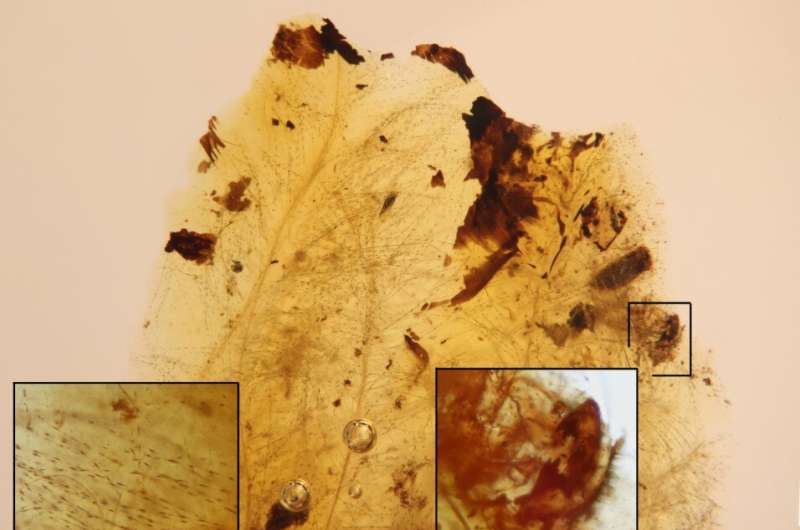This article has been reviewed according to Science X's editorial process and policies. Editors have highlighted the following attributes while ensuring the content's credibility:
fact-checked
peer-reviewed publication
trusted source
proofread
Fossils reveal the long-term relationship between feathered dinosaurs and feather-feeding beetles

New fossils in amber have revealed that beetles fed on the feathers of dinosaurs about 105 million years ago, showing a symbiotic relationship of one-sided or mutual benefit, according to an article titled "Symbiosis between Cretaceous dinosaurs and feather-feeding beetles" published in Proceedings of the National Academy of Sciences today.
The main amber fragments studied, from the Spanish locality of San Just (Teruel), contain larval molts of small beetle larvae tightly surrounded by portions of downy feathers. The feathers belonged to an unknown theropod dinosaur, either avian (a term referring to "birds" in wide sense) or non-avian, as both types of theropods lived during the Early Cretaceous and shared often indistinguishable feather types. However, the studied feathers did not belong to modern birds since the group appeared about 30 million years later in the fossil record, during the Late Cretaceous.
When looking at modern ecosystems, we see how ticks infest cattle, frogs capture insects with acrobatic tongues, or some barnacles grow on the skin of whales. These are just a few of the diverse and complex ecological relationships between vertebrates and arthropods, which have coexisted for more than 500 million years. The way that these two groups have interacted throughout deep time is thought to have critically shaped their evolutionary history, leading to coevolution. Nevertheless, evidence of arthropod-vertebrate relationships is extremely rare in the fossil record.
The larval molts preserved in the amber were identified as related to modern skin beetles, or dermestids. Dermestid beetles are infamous pests of stored products or dried museum collections, feeding on organic materials that are hard for other organisms to decay such as natural fibers. However, dermestids also play a key role in the recycling of organic matter in the natural environment, commonly inhabiting nests of birds and mammals, where feathers, hair, or skin accumulate.

"In our samples, some of the feather portions and other remains—including minute fossil feces, or coprolites—are in intimate contact with the molts attributed to dermestid beetles and show occasional damage and/or signs of decay. This is hard evidence that the fossil beetles almost certainly fed on the feathers and that these were detached from its host," explains Dr. Enrique Peñalver, from the Geological and Mining Institute of Spain of the Spanish National Research Council (CN IGME-CSIC) and lead author of the study.
"The beetle larvae lived—feeding, defecating, molting—in accumulated feathers on or close to a resin-producing tree, probably in a nest setting. A flow of resin serendipitously captured that association and preserved it for millions of years."
"Three additional amber pieces each containing an isolated beetle molt of a different maturity stage but assigned to the same species were also studied, allowing a better understanding of these minute insects than what is usually possible in paleontology," says Dr. David Peris, from the Botanical Institute of Barcelona (CSIC-Barcelona City Council) and co-author of the study. The most impressive, complete specimen was found in the amber deposit of Rábago/El Soplao in the northern Spain, roughly of the same age as San Just.
"It is unclear whether the feathered theropod host also benefitted from the beetle larvae feeding on its detached feathers in this plausible nest setting," says Dr. Ricardo Pérez-de la Fuente, from Oxford University Museum of Natural History and co-lead author of the study. "However, the theropod was most likely unharmed by the activity of the larvae since our data show these did not feed on living plumage and lacked defensive structures which among modern dermestids can irritate the skin of nest hosts, even killing them."
More information: Peñalver, Enrique et al, Symbiosis between Cretaceous dinosaurs and feather-feeding beetles, Proceedings of the National Academy of Sciences (2023). DOI: 10.1073/pnas.2217872120
Journal information: Proceedings of the National Academy of Sciences
Provided by University of Oxford



















